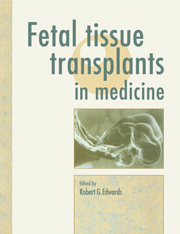Book contents
- Frontmatter
- Contents
- List of contributors
- Preface
- 1 Differentiation and transplantation of embryonic cells in mammals
- 2 Organogenesis and central nervous system development
- 3 Experimental human hematopoiesis in immunodeficient SCID mice engrafted with fetal blood-forming organs
- 4 Ontogeny of human T- and B-cell immunity
- 5 The procurement of human fetal tissues for clinical transplantation. Practice and problems
- 6 Transplantation of fetal haemopoietic and lymphopoietic cells in humans, with special reference to in utero transplantation
- 7 The biology of fetal brain tissue grafts: from mouse to man
- 8 Clinical results of transplanting fetal pancreas
- 9 The suitability of fetal and infantile donors for corneal transplantation
- 10 Transplantation of ovaries and testes
- 11 Cell grafting and gene therapy in metabolic diseases
- 12 The low temperature preservation of fetal cells
- 13 Law and ethics of transplanting fetal tissue
- Appendix: Code of practice on the use of fetuses and fetal material in research and treatment
- Brief bibliography on various aspects of transplanting fetal 337 tissue
- Index
12 - The low temperature preservation of fetal cells
- Frontmatter
- Contents
- List of contributors
- Preface
- 1 Differentiation and transplantation of embryonic cells in mammals
- 2 Organogenesis and central nervous system development
- 3 Experimental human hematopoiesis in immunodeficient SCID mice engrafted with fetal blood-forming organs
- 4 Ontogeny of human T- and B-cell immunity
- 5 The procurement of human fetal tissues for clinical transplantation. Practice and problems
- 6 Transplantation of fetal haemopoietic and lymphopoietic cells in humans, with special reference to in utero transplantation
- 7 The biology of fetal brain tissue grafts: from mouse to man
- 8 Clinical results of transplanting fetal pancreas
- 9 The suitability of fetal and infantile donors for corneal transplantation
- 10 Transplantation of ovaries and testes
- 11 Cell grafting and gene therapy in metabolic diseases
- 12 The low temperature preservation of fetal cells
- 13 Law and ethics of transplanting fetal tissue
- Appendix: Code of practice on the use of fetuses and fetal material in research and treatment
- Brief bibliography on various aspects of transplanting fetal 337 tissue
- Index
Summary
A BANK OF CELLS AND TISSUES that are conveniently available for experimentalists and clinicians is clearly desirable. Storage at standard refrigerator temperatures (4°C) cannot be used for most cells for periods longer than a few hours without serious imbalances in ion concentrations, protein conformation and, in particular, cytoskeletal structure. Microtubules are very temperature sensitive and effects may or may not be reversible, depending on the time and temperature of exposure. Although most of these observations were made with mouse oocytes (Johnson & Pickering, 1987) similar changes in microtubules can be seen with tissue culture cells (M. A. Hammer & M. J. Ashwood- Smith, unpublished observations).
Cryopreservation at temperatures that are lower than — 130°C permits the banking of most individual cells of biological and medical interest (Ashwood-Smith & Farrant, 1980) and has, in recent years, had an important impact on animal breeding and the clinical practice of IVF with the successful preservation of embryos (CIBA Foundation, 1977; Ashwood-Smith, 1986). Before discussing the progress made in fetal tissue cryopreservation a brief overview of cryobiological principles is apposite.
Basic cryobiology
Cells and tissues must be stored at temperatures lower than — 130 °C to ensure complete stability, otherwise some reactions and the recrystallization of ice can still occur. Cells may, however, be kept at — 70 °C to -80°C for several months without undue damage. Cryopreserved cells in liquid nitrogen (—196 °C) can be stored for many years. However, ten years is the maximum recommended time for human embryos, although this time limit has no scientific basis, since the effects of ionizing radiation (both cosmic and from radioactive isotopes) are so small as to constitute no hazard. A period of 32000 years of storage at -196 °C would lead to an accumulated dose of approximately 3.5 Gy (350 rads) which is the LD50 for most mammalian cells and over a ten year period in the frozen state an embryo would be exposed to an accumulated and fractionated dose of approximately 0.001 Gy (0.1 rads). These calculations take into account the combined radioprotective effect of temperature and the cryoprotectant (glycerol or dimethyl sulphoxide). Upon cellular resurrection from the frozen state, accumulated damage to the DNA is manifested, since the normal DNA repair enzymes cannot function at cryogenic temperatures (Ashwood-Smith & Grant, 1977).
- Type
- Chapter
- Information
- Fetal Tissue Transplants in Medicine , pp. 299 - 322Publisher: Cambridge University PressPrint publication year: 1992



